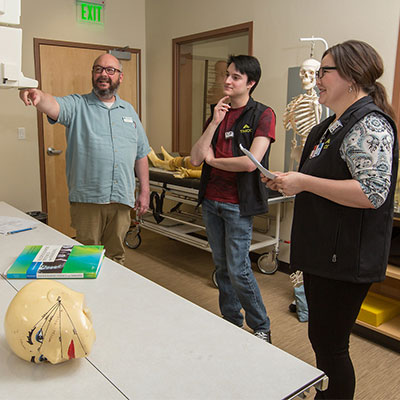
The Radiologic Technology program will expand next fall, admitting 24 students for the first time.
If you’ve ever been involved in a car accident or injured yourself doing the sport you love, chances are you’ve made a trip to the doctor’s office where they employed a Radiologic Technologist to take an x-ray, CT or MRI of your injury to determine the extent to which you are injured, and the proper form of care. Given the likelihood of needing these kinds of services, it’s easy to see why the need for Radiologic Technologists in our community—and nationwide—is great.
TMCC’s Radiologic Technology program is answering this need: in fall 2019, the program will expand to accept 24 students. This change was approved by JRCERT (one of the program’s two accrediting bodies), which will enable more students to become Radiologic Technologists in our community.
Kimberly Harn teaches Exploration of Radiology (RAD 101), a class that gives interested students a broad definition of what Radiologic Technologists do. The class, she said, is capped at 60. “If you’re interested in this program, you should register for RAD 101 as soon as you can,” she advised.
About the Program
The Radiologic Technology program is a fast-paced and demanding two-year program. “When I was first admitted to the program, I thought: ‘how will I get all of this done?’ ” said second-year student Erin O’Connell. “Now, looking back, I realized it went really fast.”
Students who apply and are accepted into the program are expected to succeed, both in the clinical component of the program that totals 1,680 clinical hours—more hours than is required of students in nursing programs. The material, too, is cumulative. “When students take a class, it’s not only to get a grade. They are learning information that they will need to pass the National Registry Exam. Mastery of the material is a requirement of the program,” said Program Director Warren Hejny.
The high standards to which Radiologic Technology students are held pays off: the pass rate for the credentialing examination is nearly 100%. “We’ve had only one student not pass since 1995,” said Hejny. So too, job placement is considerably high: since 2014, on average 97.4% of graduates are employed within six months after graduation.
Making the Commitment to Become a Radiologic Technologist
Every year, the Radiologic Technology program receives 40-60 applications. Even with the increased number of spots available, at least 40% of applicants every year will not be admitted to the program. The highly competitive selection process for applicants is point-based, and the difference between gaining admission or not often comes down to less than a tenth of a point.
Second-year student Christie Joralemon—who will graduate from the program this May—advises prospective students to start working on the program’s prerequisites now. “I pushed myself to get that A in every class because the extra points make a difference in who gets into the program, and who doesn’t,” she said.
In addition to the required prerequisite courses, prospective students must have already completed CNA training or have proof of current certification as a Certified Nursing Assistant. This focus on patient-centered care is unique among Radiologic Technology programs in Nevada, but an aspect that faculty and students feel is essential to success in the profession.
“Don’t apply if you’re not sure this is what you want to do,” said Joralemon who lives in Coleville, which means she commutes 90-minutes each way to reach the Health Sciences Center. “It’s going to be hard.” Yet, it will also be a rewarding experience that you will share with your cohort and community. Radiologic Technology is a career that, due to its technical skill paired with the rewards of helping others, it’s easy to become passionate about.
Over 80% of students are a part of Lambda Nu, the honors society for Radiologic Technologists. “Ninety-five percent of our part-time faculty are alumni of the program,” said Harn. “They are dedicated to the profession and definitely to our students.”
X-Rays Are an Art
First-year Radiologic Technology student Jazmynn Kimsey has a personal commitment to pursuing a profession that will help others. “I fell in love with the medical profession when I was 9 years old. That was the year my brother passed away, and I decided I wanted to do something to help people.” Kimsey entered the program with the hope of, eventually, working with cancer patients in Radiation Therapy. “I thought I would start with x-rays first,” she said.
Kimsey, who is also an amateur photographer, found that Radiologic Technology enabled her to merge her passion to help others with her other love of photography. “It’s also an art,” she remarks. She cites the concepts of contrast and density, which control the quality of the image. “If it’s not right, my heart just sinks,” she said. “But, the program has allowed me to fit my world as a photographer with this one.”
Hejny insists that students understand that the program and the profession are not to be taken lightly; Radiologic Technologists expose patients to ionizing radiation everyday, which requires technical skill and basic nursing skills.
“We do so much more than just push a button,” said Joralemon. Additionally, Radiologic Technologists must complete 24 hours of continuing education every two years.
If you are interested in the Radiologic Technology program, contact the department at 775-850-4003.






